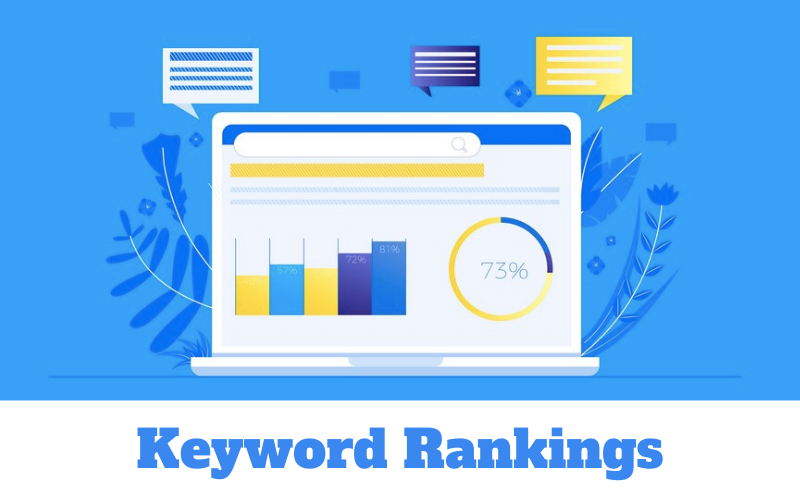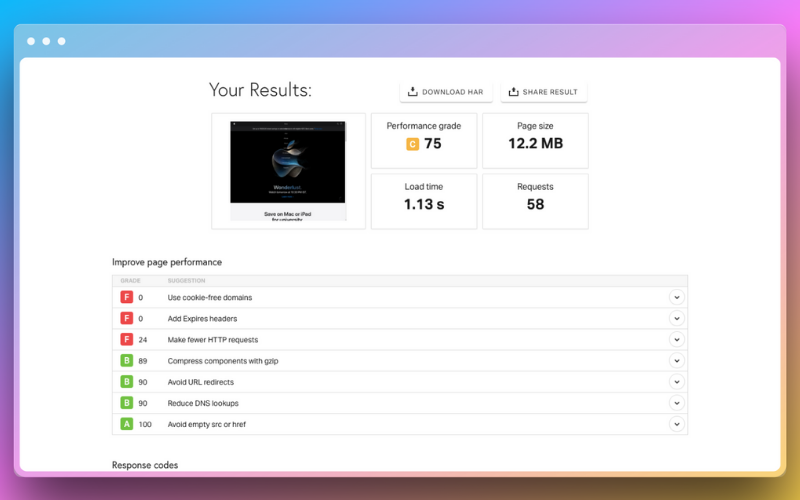Top 10 Key Website Performance Metrics That You Must Track
Published By: Rishabh Dhiman Published On: 12 Sep 23 7 Min Read
Did you know that website performance metrics like page load time can impact a site’s bounce rate, potentially increasing it by 32% when load times extend from 1 second to 3 seconds?
Everyone wants a high-performing website that makes a good first impression on new visitors and encourages existing customers to return. The aim is to ensure a positive customer experience (CX) at every level.
That is why it is very important to know the website performance KPIs to measure your website performance.
If you want to build a website with interactive UI and faster loading speed, you must get it developed by experts at Believ-In Technologies.
In this blog, we will discuss what website performance metrics are and some top site performance metrics that will help you measure website performance.
Table of contents
- What are Website Performance Metrics?
- Why Should You Track Website Performance Metrics in 2023?
-
10 Key Metrics For Website Performance
- Rate of Error
- Keyword Rankings
- DNS Resolution Time
- Bounce Rate
- Maximum Response Time
- Page speed and load time
- Special Visitors
- Uptime
- Click-Through Rate
- Conversion Rates
- Wrapping It Up
What are Website Performance Metrics?
Website performance metrics are key indicators of a website’s speed, responsiveness, and overall user experience. They include load time, page speed, server response time, and mobile-friendliness. These web performance metrics provide valuable insights into a website’s efficiency, directly influencing user satisfaction and search engine rankings.
In addition to tracking user engagement and business success, web page performance metrics such as bounce rate and conversion rate play a vital role. It is essential to regularly monitor and optimize these web performance metrics to maintain a seamless and impactful online presence.
The key website metrics to measure website performance include factors such as DNS resolution time and content delivery efficiency. These factors directly impact the speed at which a webpage loads and displays its content.
An efficiently optimized website that meets these criteria not only enhances the user experience but also supports improved SEO. This will ultimately benefit both users and website owners.
Why Should You Track Website Performance Metrics in 2023?
Tracking website performance metrics is essential for several compelling reasons. These metrics offer valuable insights into the user experience. Load time, page speed, and bounce rate provide information about how quickly visitors can access and engage with your site. A positive user experience leads to satisfaction and promotes repeat visits.
In addition, search engine rankings are influenced by website performance metrics. Major search engines like Google take into account factors such as page loading speed and mobile-friendliness when determining where a site will appear in search results. Improving these metrics can greatly improve visibility and drive more organic traffic to the website.
Moreover, website monitoring metrics are helpful in identifying and resolving issues promptly. By tracking metrics, we can easily pinpoint the source of errors or slowdowns, enabling swift rectification and minimizing user frustration.
In the highly competitive digital landscape, monitoring website performance metrics is not just advantageous; it is essential.
10 Key Metrics For Website Performance
In the modern digital era, a website’s performance plays a crucial role in user satisfaction, SEO rankings, and overall business success.
To ensure optimal website functionality, it’s important to monitor and analyze various web page performance metrics.
Let’s explore ten impactful metrics for measuring website performance.
Rate of Error

The rate of error helps you track the percentage of request issues that your site has generated in comparison to the total number of requests.
A high rate of errors like 404 errors can be frustrating for visitors and potentially damaging the credibility of a website. By monitoring and addressing error rates promptly, issues can be identified as well as resolved. It will ensure a seamless browsing experience free from errors.
Keyword Rankings

Keyword rankings refers to the position in which your website appears in search engine results for specific keyword search or queries.
Monitoring keyword rankings is crucial for assessing the success of SEO strategies. By improving rankings for relevant keywords, businesses can increase organic traffic and visibility, ultimately enhancing their website’s performance.
Regular tracking and optimization of keyword rankings enable companies to maintain a competitive edge in the digital landscape. It attracts more potential customers, as well as achieve greater online success.
DNS Resolution Time
When it comes to evaluating website performance, one of the important website key performance indicators to consider is DNS (Domain Name System) resolution time. This measures how long it takes for a user’s device to translate a website’s domain name into the corresponding IP address.
Faster DNS resolution leads to quicker access to the website, resulting in an improved user experience. Conversely, slow DNS resolution can cause delays in page loading as well as frustrate visitors.
Website owners can enhance their site’s speed and responsiveness by monitoring and optimizing DNS resolution time. This helps reduce the risk of users abandoning the site and improves overall performance and reliability.
Bounce Rate

The bounce rate is an important website KPIs to track website performance and user engagement. It represents the percentage of visitors who leave a site without interacting further after viewing only one page.
A high bounce rate is often indicative of problems such as slow loading times, irrelevant content, or a confusing user interface. All of these things will have a negative impact on the overall user experience.
By monitoring and reducing the bounce rate, website owners can improve engagement, encourage visitors to explore more content, and potentially convert them into customers.
Maximum Response Time

Maximum response time usually known as peak response time (PRT) is the longest response time received by the server for all requests.
It helps you know where your website is underperforming or having issues in fulfilling requests, as it helps you make it easier to identify the problem.
Whenever working with third-party APIs it might be difficult to keep a track on how the APIs function under the client load and what their response is to the users who are far away.
Page speed and load time

Page speed refers to the time it takes for a web page to fully load and become interactive when a user clicks on it from search results, encompassing factors like loading content and images. The average load time of a website these days is 2 to 3 seconds, which is merely difficult with today’s internet connectivity.
The main problem comes when doing it on mobile networks. With the surge in mobile users, website speed is critical. Mobile networks vary, affecting resource availability and user experience. This is where the website speed is most important. It is not possible to have the same resources in all the devices as well as expect the same result as the other.
The same website that will load on your desktop in 2 seconds will load on your mobile in 2-3 seconds.
Special Visitors
A special visitor is an individual who has accessed your site during a specific period, which can be daily, weekly, or monthly. This metric is very useful as it refers to the website growth.
Website owners can use these metrics to track website performance, make informed decisions about attracting and keeping a larger audience. They can also identify peak traffic times and customize their efforts to suit user preferences.
Uptime
Uptime is a critical measure that reflects the percentage of time a website is operating and accessible to users. It’s an essential indicator of reliability and availability. Websites that frequently experience downtime can be frustrating for visitors, tarnish a reputation, and result in missed opportunities.
Your web host is responsible for uptime. Therefore, if you have regular downtime or bandwidth concerns, you should reconsider your hosting options. While no host can guarantee 100% uptime, you should aim for 99.99% uptime.
Click-Through Rate

Measuring website performance, especially in online marketing campaigns, relies heavily on a metric known as click-through rate (CTR). This metric quantifies the percentage of users who actually click on a specific link, advertisement, or call-to-action element featured on a website.
A high CTR reflects the compelling and engaging nature of the content or offers to visitors. It encourages them to take the desired actions. Website owners and marketers can effectively evaluate the success of their content, design choices, and overall marketing strategies by carefully analyzing CTR data.
Enhancing CTR leads to increased traffic flow, and conversions and ultimately boosts revenue for businesses.
Conversion Rates

The conversion rates track the number of actions the website users wish for. It reflects the act of a certain goal, like making a purchase, completing a form, or any activity that matches your website’s objective.
Conversion rates are highly configurable. They depend on your unique business goals, allowing you to identify valuable activities for your organization.
Wrapping It Up
Believ-In Technologies helps you develop your website professionally, from your website appearance to your bounce rates to your uptime and many more things to improve web page performance. We also offer website maintenance service, so if you are having some error issues with your website, we can fix that for you, too.
Whether you are creating your new website or simply trying to improve the performance of the one you have, the above-listed 10 key web performance metrics will surely help you.
By closely tracking these website performance metrics, you can make informed optimizations for your website’s success.
While you can’t exactly control how your site’s users behave, you can absolutely optimize content to influence behavior.
